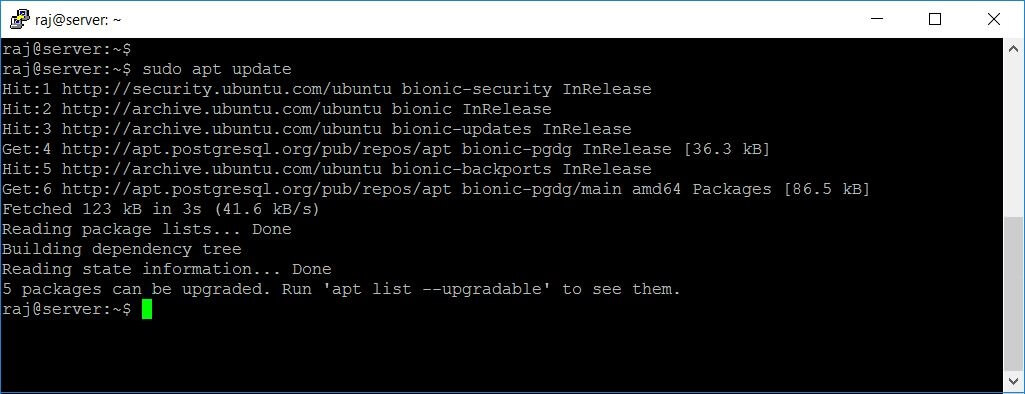

Related Documentation Migrate data from PostgreSQL to AnalyticDB for PostgreSQL L1 Terminal Fault vulnerability is eliminated.

OS fixes for Meltdown and Spectre issues are applied. Zabbix/Mamonsu monitoring solution is installed and preconfigured.
UBUNTU INSTALL POSTGRESQL PRO
This image contains Postgres Pro Standard Database 10. Postgres Pro Standard Database provides early access to new PostgreSQL features and optimizations. Related Market Product Postgres Pro Standard Database 10 (Ubuntu 16) We will also configure emails to setup pluses.
UBUNTU INSTALL POSTGRESQL HOW TO
In the second part of the tutorial, we will learn the basics of how to use the platform.


We will also set up Nginx as a reverse proxy and secure the Metabase instance using Let’s Encrypt SSL. We will use PostgreSQL to host the Metabase database. In the first part of the tutorial, we will install Metabase on Ubuntu 16.04 server. Database Visualization using Metabase Part 1 - Install Metabase on Ubuntu 16.04 You can also check this guide on How to create an instance. To follow along with this guide, you need to have an instance installed with Ubuntu OS. For Alibaba Cloud, you can create an instance and set it up manually using Elastic Compute Service (ECS) or by using ApsaraDB RDS. In this guide, we will install and set up a PostgreSQL database on an Ubuntu instance using Alibaba Cloud Elastic Compute Service (ECS).īut before we begin, it is important to know that there are different ways to set up a PostgreSQL database on any cloud provider. Related Blog Posts Setting up a PostgreSQL database on an Ubuntu instance Then you can create directory and set permissions to prepare for the installation of SonarQube following this tutorial. Step 3: Execute the following command to start and enable PostgreSQL server so that it can start automatically after reboot. # sudo apt-get -y install postgresql postgresql-contrib Step 2: Now install the PostgreSQL server by executing the command below. # sudo sh -c 'echo "deb `lsb_release -cs`-pgdg main" > /etc/apt//pgdg.list' Follow the steps below to install PostgreSQL. To avoid such restrictions, I strongly recommend using PostgreSQL. For using MySQL, you can only use bundled mysql-connector-java. In this tutorial, I will use PostgreSQL as MySQL is not recommended for large instances. SonarQube supports PostgreSQL, MySQL, MSSQL and Oracle.
UBUNTU INSTALL POSTGRESQL UPDATE
# sudo apt update & sudo apt upgrade Install PostgreSQL To execute this command, remember to login from non-root user with sudo privileges. Update Your Ubuntu Systemīefore proceeding with installation of any kind of package, use the following command to update your Ubuntu system. If you haven’t yet, you can head over to our documentation page and find out more about TimescaleDB, our open-source extension that makes PostgreSQL scalable.In this tutorial, we will be installing and configuring SonarQube on an Alibaba Cloud Elastic Compute Service (ECS) instance with Ubuntu 16.04. Option 2: psql Now you have connected via psql. Once you run that command, the prompt will ask you for your password. Now, in order to connect to your PostgreSQL server, we’ll need the following connection params: Let’s confirm that psql is installed: psql -version Last Step: Connect to Your PostgreSQL Server Note: This only installs the psql client and not the PostgreSQL database. Install on Ubuntu and Debian using the apt package manager: sudo apt-get update From your command line, run the following commands: brew doctorįinally, symlink psql (and other libpq tools) into /usr/local/bin: brew link -force libpq Install on Ubuntu 16.04,18.04 and Debian 9,10 psql -version Install on MacOS Using Homebrew In fact, if you’ve ever installed Postgres or TimescaleDB before, you likely already have psql installed. Before You Startīefore you start, you should confirm that you don’t already have psql installed. Here we explain how to install psql on various platforms. Psql is the standard command line interface for interacting with a PostgreSQL or TimescaleDB instance.


 0 kommentar(er)
0 kommentar(er)
